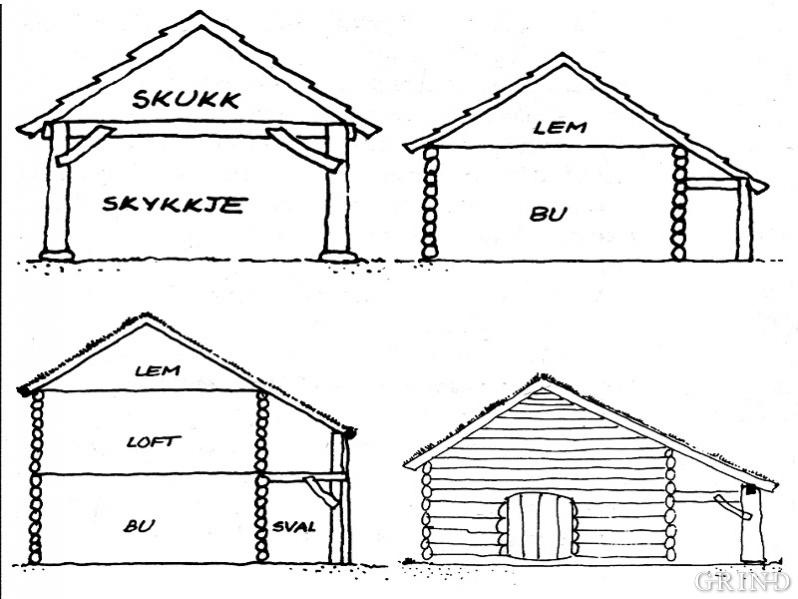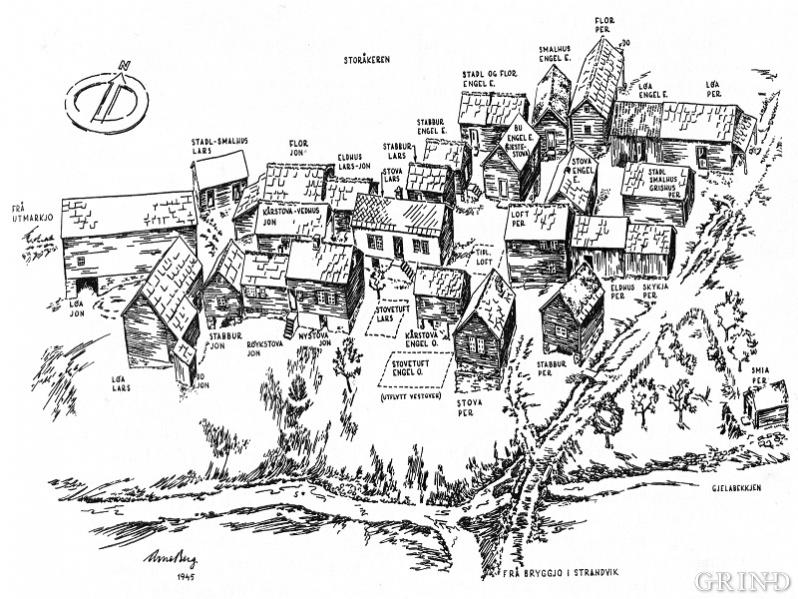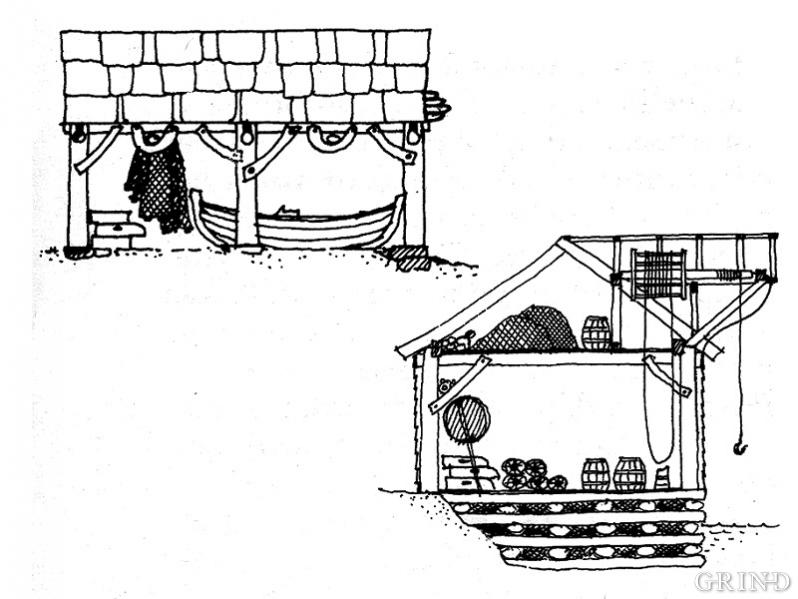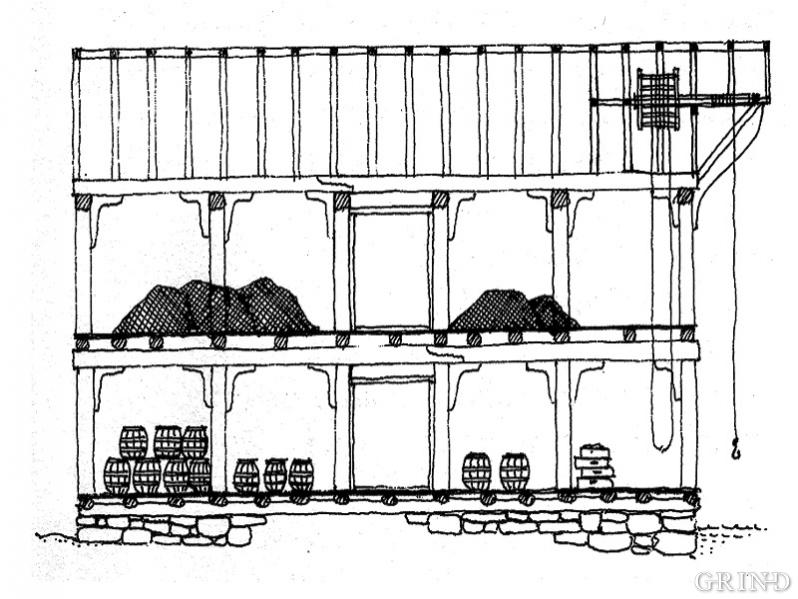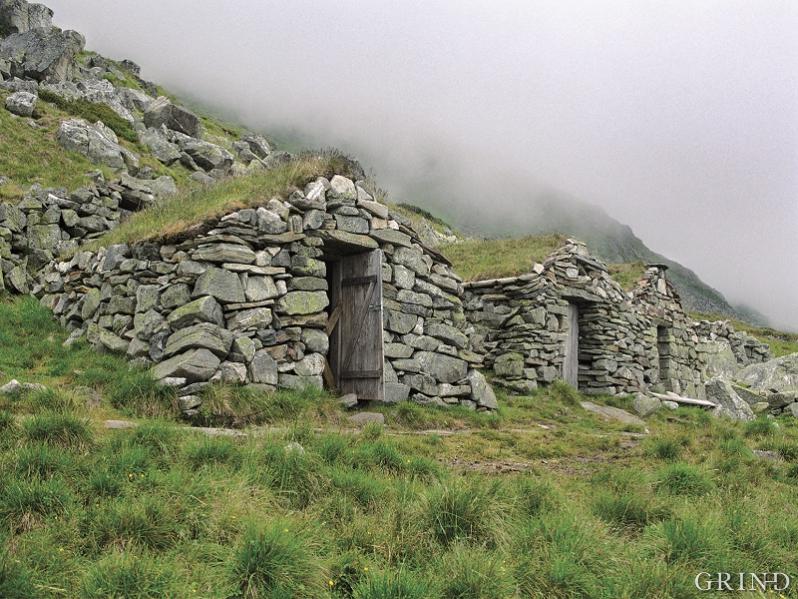Published: 19.05.2009 | Author: Nils Georg Brekke
The well constructed two-storeyed house at Skjørsand in Fusa around the end of the 19th century, in cultured Swiss style, belongs to the classical style of building in western Norway after the great period of land reform. (Svein Nord).
”It is strange what expensive dwelling houses are being erected many places in the villages now. Supposedly people think that they can do good business with city folk in the summer time. Besides at the moment it is a pretty uncertain income, and it is a big question whether it will be the best source of income at all. Now and then city folk exercise an influence which is less than good on the country folk, especially upon the upcoming generation who are becoming more and more occupied with enjoying themselves. The farmers also want to be big shots now; as we know a Ministry of agriculture has been establishment and big things are expected of it. But the farmers need to learn first of all that progress in agriculture depends first and foremost on the hard work and energy of the individual, because without that there would be little use, even if you had a Ministry in every village.”
It is the new house in a “modern style”, in the Swiss style that our travel companion stands there philosophising over, on his way into Strandvik on the steamship ”Solstrand” one Saturday afternoon in 1900. His thoughts on the development of the rural areas were to be found in the pages of one of the local newspapers, and give us a little glimpse of a contemporary view of things.
Many new houses were built at the end of the 19th century. New construction on the farms after the Land Reform, the new steamship stopping places, the country stores, hotels and guesthouses - all this caused the expansion of the Swiss style. The big well-built farm dwelling houses around the turn of the century are a style of building which demonstrate this in the west Norwegian cultural landscape. The Swiss style which arrived at the same time as the breakthrough for industrialism heralded the period of major agricultural reform and the new times which were coming to the rural districts.
“The dissolution of the extended agricutlural settlements “
Scarcely any other process of change in the old farming society has made a greater mark on the cultural landscape than the break-up of the great extended agricultural settlement, a process which began to take place for real with the Land reform laws of 1821 and 1857. Before that time farms were gathered together like small villages within the landscape, with sun-baked timber or grey, weather-beaten cladding beneath turf and stone flag roofs.
Right from the early Middle Ages up until the 19th century the image of the landscape was broadly the same. The houses were the same, but there were more and more of them as the farms were split up into new units and the land was divided up into smaller and smaller parcels. In western Norway the form of ownership was such that the buildings of all the users were situated in the same settlement, so that they saved on cultivated land and everyone got a similar distribution of parcels of good and poor land. It was this that created the system of strip-farming; this patchwork of small and big parcels for the separate users, distributed over the entire area of cultivated land. The sub-division of the farms started in Viking times, speeded up during the population increased in the 17th and 18th centuries and culminated early in the 19th century when emigration to America started up.
It was the complicated land ownership within the strip-farming pattern which generated the great land reforms in the early 19th century. They were to create the basis for a more rational agriculture. This development ran in parallel with other forces which created changes. There was a period of prosperity around the middle of the 19th century, with the development of a wider commercial foundation in the rural districts. Specialisation within handicrafts together with a growing cottage industry provided more hard cash and herring fishing and coastal shipping created jobs in the coastal districts and many tenant farmers bought up their farms from the former great estates of Lyse Monastery and Rosendal Barony.
It was precisely in those years in the middle of the 19th century when the changes in society took root, that a quiet-mannered researcher travelled round the Norwegian country districts and was captivated by the variety of building practice.
Eilert Sundt and the vernacular architecture
When Eilert Sundt , the theologian, sociologist and researcher into how people live in Norway, travelled round Norway “to study ordinary folks’ conditions and customs”, as he himself expressed it, it was quite natural for him to pay great attention to the buildings and the farms he passed by. These were important elements in the life of the common people in the rural areas. And – as he wrote in his very popular book: “On building practices in the country of Norway” – it appeared to him:
“that in our more old-fashioned districts there is something that one can call a building style. After I had gone in and out of more and more farms it occurred to me that the irregularities fell away somewhat to allow me to glimpse some of the original regularity and unity on the ground. And it occurred to me that the remarkable beauty of this irregularity became even more beautiful the more trained I became in discerning the rules and order that lay half concealed beneath. And it could certainly provide a moment’s diversion to examine this confusion engendered by this mixing; but when you have first come into this way of thinking, that the differences between these districts’ styles could be pursued up as far as a national style, from which they originated, then the sight can provide entertainment and enjoyment for several hours”
And so Eilert Sund draws up for us a fascinating picture of a historical development in which he himself in a masterly way captures human types and groups, in a charming style of presentation where he guides the reader in a careful, but friendly fashion, from one viewpoint to the next, in this motley material.
“But there is need of good fortune to display the many complications clearly and to capture the reader’s patient attention for many small things which in themselves are quite insignificant, but which create an interesting whole”
Eilert Sundt is still one of the best travel guides we can find in this historical landscape. As a building researcher with a sociological approach he was far ahead of his contemporaries in Europe. His gallery of house types such as the “Akershus type”, the “Mandal type”, the “Jaeder room type” has served as a platform for our knowledge of people’s building practices and his interpretations have acquired great authority – so great that they have become something of a straitjacket on researchers, right up to our own times.
“Room and store”
One matter that Eilert Sundt was always concerned with, and one which we can see he worked with and pondered on throughout the whole of his book on building style, was the interrelationship between the “main room” and the “store”, the room with the hearth or the fire and the store or the attic; the two main functions in the farmhouses in the different rural areas. He wrote in his chapter on smoking rooms:
“ .. this collection of buildings, smoke rooms or living rooms, as well as larders, cupboards and stores is just how, as I said above, I imagine the beginning of the very olden times”
He forms an opinion after a while on how development must have taken place. His hypothesis on the development of the “Jær room form”., the Jær house has remained a classic of development theory.
“Originally this, as shown elsewhere in the country, has been a building divided in two, with a living room and a store with a split between an upper and a lower part, one being for clothes and a guest’s bed, and the other for foodstuffs … And now we only need a slight change in thinking, so that we can imagine the change in the old custom, for the store to be moved close in to the living room and to be joined up with the hall which was between the two”
It is precisely this “slight change in thinking” which has become - quite literally - an established viewpoint which only today we can see in a new light, based on new documentary evidence. Archaeological investigations in the last few decades have shown that in the coastal rural districts in western Norway and in the mountain valleys, long terraced houses must have existed in the Middle Ages with clear dwelling functions in a straight line, that is the “room and the store”, a room with, and a room without a hearth. This is supported by recent investigations of Faeroese building customs, where in recent years well founded interpretations have been put forward that the conjunction of the smoke room and the living room with a window on the Faeroe Islands was the medieval form of living. And the background for the Faeroese building traditions are exactly those to be found in western Norway.
If we now complete Eilert Sundt’s “change in thinking” and recognise that the functional conjunction of important dwelling functions under the same roof is actually the medieval building practice in many districts, then we get an image of a completely different development, partly the opposite of what Eilert Sundt thought of!
The longhouse tradition in the heath landscape
In the outer coastal districts we find traces of buildings which have been put together as longhouses with living room, hearth, storeroom and store all under one roof. The ruined farms at Lurekalven in Lindås and at Høybøen on Sotra – in use until the Black Death – show us these houses and many more recent facilities from the 17th and 18th centuries tell of a tradition which lasted up until the 19th century. The smoke room - the living room in Norwegian rural districts for a thousand years - could be incorporated in different collections and functional combinations of living room, hearth, store and loft. Much goes to indicate that this building practice represents the dwelling traditions of the Middle Ages, traditions which have lasted in the coastal districts and the fjord districts right up until the 19th century. And thus we have a completely different basis for understanding the development than Eilert Sundt had. In the inland districts in Voss and Vossestrand we also find traces of this way o building, as we see in the long rows of rooms set together in Oppheim’s old vicarage. And it is especially the folk from Voss district who have maintained the tradition of the smoke rooms and the terraced hamlet. This is not really so remarkable. Voss has always been one of the most traditional areas in the country.
The clustered community – The social landscape
There were close living relationships in the old hamlets with such forms of building, and sharing rooms was not unusual. In many ways we can say that the pattern of strip farming in the old west Norwegian agriculture had its counterpart in the intermingling of houses in the hamlet.
When a new plot was parcelled out it was not always that the new user got his house built immediately. The buildings were divided up on the same principle as the strips, the hayshed was divided along one of the cross-beams, and the hayshed could be divided up between many users. The raised storehouse and the cowshed were usually the buildings that the new owner put up first for himself, then the living room and the sleeping quarters, whilst the hearth and the hayshed were the buildings that could be used together with others for the longest.
We have a striking example of the spirit of community between the owners from Indre Drange farm in Os, where the old farm building which the owners had previously used in common, was divided up between the neighbours in this way in 1753:
“1 smoke room with two eaves and a shed which previously belonged to both Mons and Anders, but now Anders has relinquished his half part to Mons so that Anders shall have the right to have a milkshed standing under the eaves of the long side of the building”
Thus Anders has handed his part of the old farm building over to Mons, in return for the right to use the eaves on one side of the building and to have a milk store standing in Mons’ room!
This partly complicated intermingling of rooms and building was just as characteristic for the old hamlet group as it was for the strip farming system. Several households could share the main house over a long period of time. It is difficult for us to imagine how closely together people lived in such rooms. The social rules of interaction would have had to have been fine-polished for people to be able to live so close together. In one of the old rooms in Sandvenstunet in Kvam, in the big “Brigta Room” several households lived together. Here there was a fixed custom that the wives got up on cold winter mornings to make the fire and to start up the preparation of the food whilst the men gathered together on a bed frame and lay and chatted until the food was ready!
The houses built together in groups in western Norway, with sheds, extensions, lean-tos frame-built around the timbered living rooms are part of the North Atlantic building style. And in the 19th century rooms with lofts, where the living room and the store are situated symmetrically on each side of the central passage and the kitchen, there lie hidden many reconstructions of multiple roomed houses from the 17th and 18th centuries.
Stave and stone
On the outskirts of the hamlet lay the working buildings, the hayshed built with staves or in framework.
Buildings made from wooden staves, as we know that form of construction from haysheds, out-buildings and boatsheds right up until the first half of the 19th century, represent a prehistoric building tradition. Whether the use of materials in the outer walls around the stave construction go as far back in time, is difficult for us to decide today. There is much to suggest that walls clad with juniper branches was a very ancient technique; a variant of many different plaiting techniques which are known in Scandinavia and northern Europe.
It is interesting to see these ways of building in the perspective drawn up by agricultural historians; that the agricultural working methods from Viking times lasted right up until the tractor and industrial agriculture took over in the 20th century. If we make use of the term “ecological” building practice, we can hardly use it with greater accuracy than with the framework building tradition. Primitive is not the correct word, because within it lies a well thought out functionalism and material technology in this way of building with grey stone walls, stone flags set up on end and juniper cladding as an outer “skin” against the weather around the stave construction inside.
Juniper cladding is often used in combination with other techniques. Framework construction consists of a free-standing, self-supporting skeleton and as we see from the isometric cross section of a hayshed in Havråtunet on Osterøy, the juniper walls are threaded with sticks which are fastened on the outside of the posts themselves In many of the smaller haysheds the sticks are fastened directly on to the posts.
Many of the haysheds built of staves have juniper cladding on all four walls, but some of the buildings also have big protective walls in stone on the sides which are most exposed to driving rain and the storms from the south-west. We can often see that grey stonewalls, wooden cladding and juniper cladding have been used on the same building.
Juniper wood does not rot, but stays fresh for many generations. The juniper needles form a dense wall that keeps the rain out and lets the wind through. As a storage space for hay juniper clad buildings are therefore ideal buildings seen from a functional point of view. Hay which was damp when it was brought into the shed would dry out well in a juniper hayshed. And the tanning shed could also be covered with juniper. This was so that the skins and hides could hang up in the air and dry out well after tanning. At Brakvatn (Juniper Lake) on Osterøy, there is a juniper-clad tannery, probably one of the oldest in western Norway.
Marine industry
For hundreds of years the coast of western Norway has been characterised by a divided means of making a living. The sea has been the main means of transport and marine activity provided a very welcome addition to the farming household. From far back in time marine warehouses and boatsheds belonged to most of the farms along the coast and up in the fjords as part of the working buildings on the farms. It was just as important for the farms lying high up to have a boatshed as it was for the farms on the fjord, in order to have space to store and load goods. At Fosse in Hardanger it was the mountain farms at Haukås and Engedal which were the most entrepreneurial as far as sloop transport and trade with Nordland in North Norway were concerned. Both of them had their boatsheds in Fossevågen, and it was busy in spring when they impregnated the nets in Fossfjøra and when the sound was full of sloops. In many rural communities it was usual that the farmers who engaged themselves in taking part in the fisheries each year had a place to sleep in the loft in the boathouse. The netting groups often got big nets together for 5 or 6 users, and they built their own netting sheds with room for the seine boats and the light boats on the first floor and nets, barrels and floats up in the loft or in other higher parts of the big net sheds. Each time the equipment had been in the sea it had to be dried out and it was usual to have a net hanger for this purpose in places that were easy to reach from the sea.
Up in the fjords we find many boatsheds and boathouses with links to typical secondary trades related to fisheries; production of herring barrels and fish boxes. One of the most traditional handicrafts in the west of Norway, boatbuilding, has certainly been influenced by the state of prosperity in the fishing industry, and many boat builders have stood there and hammered out four-oared rowing boats in the boatsheds along the shores. On the flap of the shed it was usual to store boat materials for a year before they would be used.
There is a characteristic distinction between boatsheds and boathouses in their siting. The boatsheds were usually sited safely back from the level of the flood tide so that there was room to pull a boat up on to shoreline or to the boatshed in front whilst the boathouses were sited out in the sea on a timber bulwark, stone pillars or stone wall so that it was possible to come right in with a boat for loading and unloading.
However the most striking difference was architectural: the boathouse is higher and has a winching ark or a winching house in the gable or on the long side, a purely functional building component with a fixed design, influenced by curving lines from the language of the Baroque form.
The small boat stores, stave construction in its simplest form, and the stone built boatsheds are building techniques that we also find in the mountain pasture buildings.
Huts and cottages in the mountain pastures
The Gulating Law contains regulations on the use of maintain pastures, on the keeping of cattle, on travel from the pastures, on grazing rights and property boundaries, so even in those times the use of mountain pastures was an important part of farming practice.
It was the building practice in the rural districts which also influenced the buildings in the mountain pastures. On Hardanger plateau, on the Voss districts and in Stølsheimen we come upon many common features. When we have had enough of untouched nature on our travels in the mountains it can be very pleasant to come upon the old mountain pasture farms. Many of the higher-lying mountain huts are half buried in the ground; a very ancient feature. But whether the building is built of stone or wood, there is an interesting distinction in the mountain pasture building itself and its function: In Stølsheimen there is the outhouse - built in framework timber - in front of the cog-jointed cottage itself. There is a hearth in the outhouse and here cheese is made, whilst the cottage is the living quarters. On the Hardanger plateau the outhouse and the living room are often situated side by side. The servant girl boils the milk and makes the cheese, and she also had her bed here, whilst the milk products were stored in the storeroom attached to the living quarters. But the outhouse, the shed and the living quarters are all part of the same building system.
For centuries stone has been a good building material in treeless regions where they had to economise on resources. On the high mountains or on the plateaux, open heaths out towards the sea we come upon stone construction in its lean architectural form; a part of a great North Atlantic cultural community.
- Brekke, N. G. (1978) Byggetradisjonar på Hardangervidda. I: Den Norske turistforenings årbok, s. 129-147.
- Brekke, N. G. (1980) Byggjeskikken i det gamle Os. I: Bygdesoga for Os: kulturhistorisk band. S. 335-449.
- Brekke, N. G. (1982) Samanbygde hus i Hordaland: langhustradisjonar i vestnorsk byggeskikk. I: Foreningen til norske fortidsminnesmerkers bevaring, Årbok. Oslo, Foreningen, s. 51-114.
- Engevik, A. K. & Munksgaard, J, H. (1975) Byggeskikk i Nordhordland: utvikling av bustadhus på 1700 og 1800 talet. Rapport, Universitetet i Bergen, Lindåsprosjektet, nr. 14. Bergen, Fylkeskonservatoren i Hordaland.
- Sundt, E. (1976) Om bygnings-skikken på landet i Norge. Verker i utvalg, nr. 6. Oslo, Gyldendal.
- Vreim, H. (1935) Faskarløer og brakekledning. I: Årbok (Universitetets oldsaksamling). Oslo, Oldsaksamlingen.





